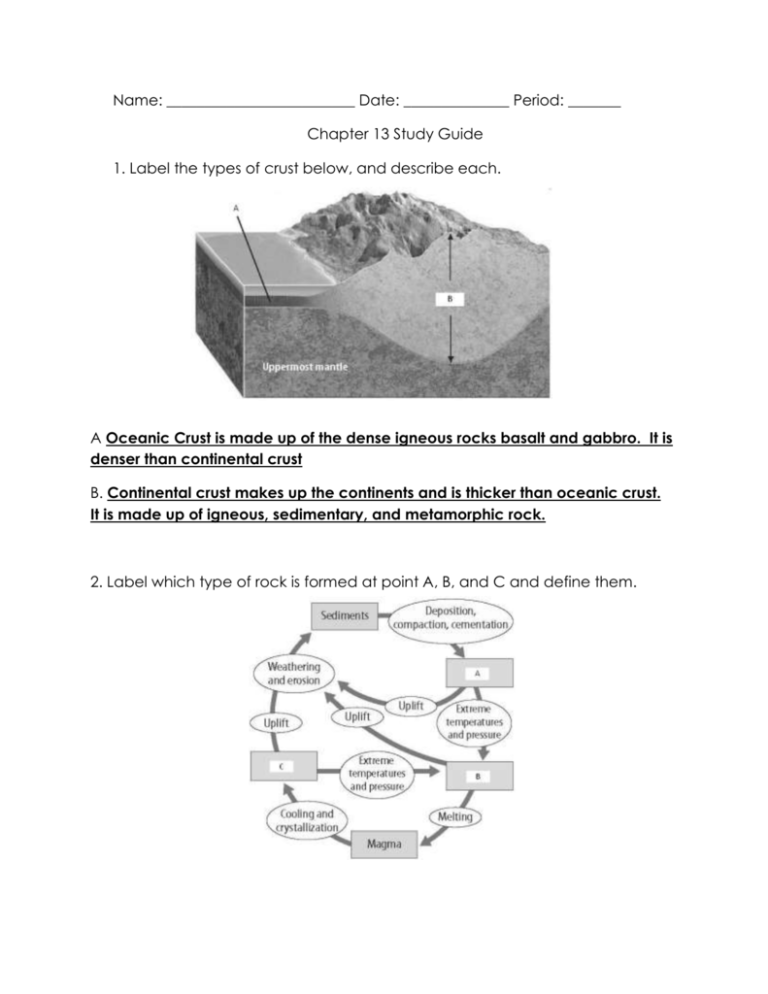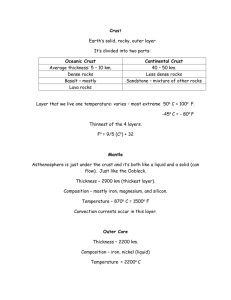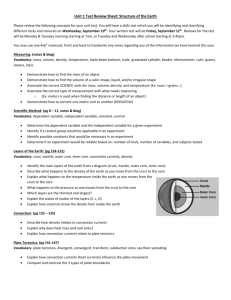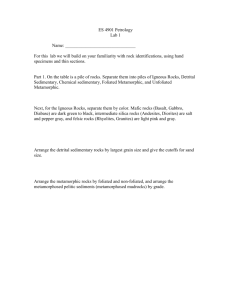Name: Date: Period: ______ Chapter 13 Study Guide 1. Label the
advertisement

Name: _________________________ Date: ______________ Period: _______ Chapter 13 Study Guide 1. Label the types of crust below, and describe each. A Oceanic Crust is made up of the dense igneous rocks basalt and gabbro. It is denser than continental crust B. Continental crust makes up the continents and is thicker than oceanic crust. It is made up of igneous, sedimentary, and metamorphic rock. 2. Label which type of rock is formed at point A, B, and C and define them. A Sedimentary: Formed when sediment is eroded by water, wind, ice, or gravity and deposited in layers B Metamorphic: Formed when sedimentary, igneous, or other metamorphic rocks are subjected to high temperatures and extreme pressure C Igneous: Formed when molten rock material cools and hardens 3. Define each of the 4 Earth Systems, and given an example of something found in each. Atmosphere: the outer most system made up of a mixture of gases and particles of matter; oxygen and nitrogen and the ozone layer can be found here Hydrosphere: contains all of Earth’s water; most of which is found on Earth’s surface. Water vapor in its gaseous state Geosphere: includes the thin layer of soil and rocks on Earth’s surface and all of the underlying layers of Earth; example a cliff Biosphere: all the living things on Earth; example people 4. What is the least dense layer of the geosphere? Outer crust 5. What is the most dense layer of the geosphere? Inner core 6. The core is made up of metal iron and nickel. 7. Describe the mantle; be sure to include information on the asthenosphere and the lithosphere. The mantle is the thick, middle layer of the geosphere. The lithosphere is made up of the crust and the uppermost mantle to form a brittle outer layer. The asthenosphere is the weak, partially melted layer of the mantle 8. Describe the core; include information on both the outer core and inner core. The core is the dense, metallic center of the Earth. The outer core is made up of liquid iron and nickel due to the high temperatures in the center of the Earth. The inner core is a dense, solid ball of iron and nickel. 9. The metal needle in a compass aligns with the magnetic field of Earth. 10. What are phosphates? When oxygen combines with phosphorus it is called a phosphate 11. Dead and decaying animals provide nutrients for soil. 12. Describe each of the four cycles. The water cycle is the continuous movement of water on, above and below Earth’s surface. The rock cycle is the series of processes that change rocks from one form to another. The carbon cycle is the series of processes that continuously move carbon among Earth systems. The phosphorus cycle is the series of processes that move phosphorus among Earth systems. 13. During the carbon cycle name one way that Carbon dioxide is removed from the atmosphere and one way it is put into the atmosphere. Removed: absorption of carbon dioxide by water, photosynthesis, stored in fossil fuels. Enters the atmosphere: released by volcanism, cellular respiration, burning fossil fuels, decomposition, forest fires and deforestation 14. What is cleavage? The tendency of minerals to break along smooth, flat surfaces 15. What is luster? The way a mineral’s surface reflects light 16. What is streak? Color of a minerals powder 17. What is hardness? Uses the Mohs scale which ranks mineral a scale of 1 to 10. 1 being the hardest; diamond is the hardest mineral and is ranked at a 1 18. What is fracture? The tendency of a mineral to break along irregular surfaces 19. Water can be found in three phases, name them. Water, ice, and water vapor Essays 1. Name and describe each of the three main layers of the Earth. The three main layers of the Earth are the crust, mantle, and core. The crust is the outermost layer and the least dense. It contains both continental and oceanic crust. The mantle is the largest layer and contains both the lithosphere and the asthenosphere. The core is the center-most layer made up of iron and nickel. It has an outer, liquid core and a solid inner core. 2. Name and describe the three types of rocks. The three main types of rocks are igneous, metamorphic and sedimentary rocks. Igneous rocks are formed when molten rock material cools and hardens. Metamorphic rocks are formed when sedimentary, igneous, or other metamorphic rocks are subjected to high temperatures and extreme pressure. Sedimentary rocks are formed when sediment is eroded by water, wind, ice, or gravity and deposited in layers. 3. Name and describe the four Earth systems. The four Earth systems are the atmosphere, hydrosphere, biosphere, and geosphere. The atmosphere is the outer most system made up of a mixture of gases and particles of matter. The hydrosphere contains all of Earth’s water; most of which is found on Earth’s surface. The geosphere includes the thin layer of soil and rocks on Earth’s surface and all of the underlying layers of Earth. The biosphere is all the living things on Earth.








